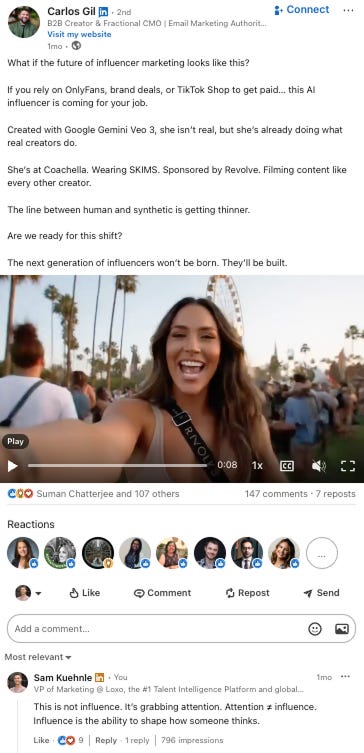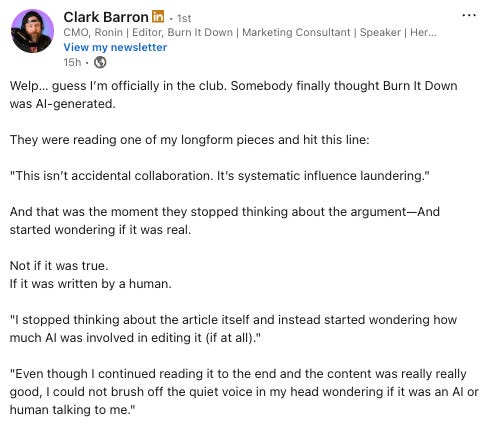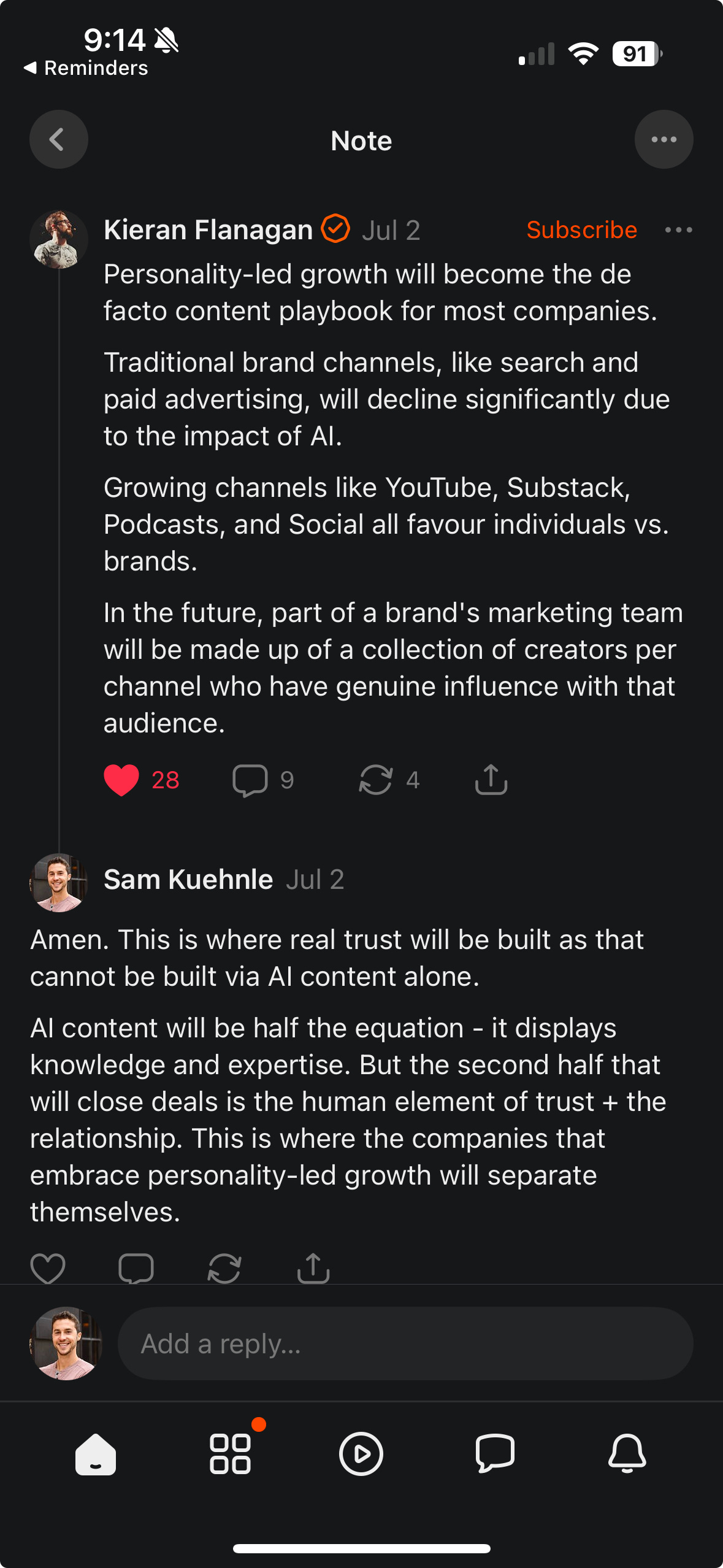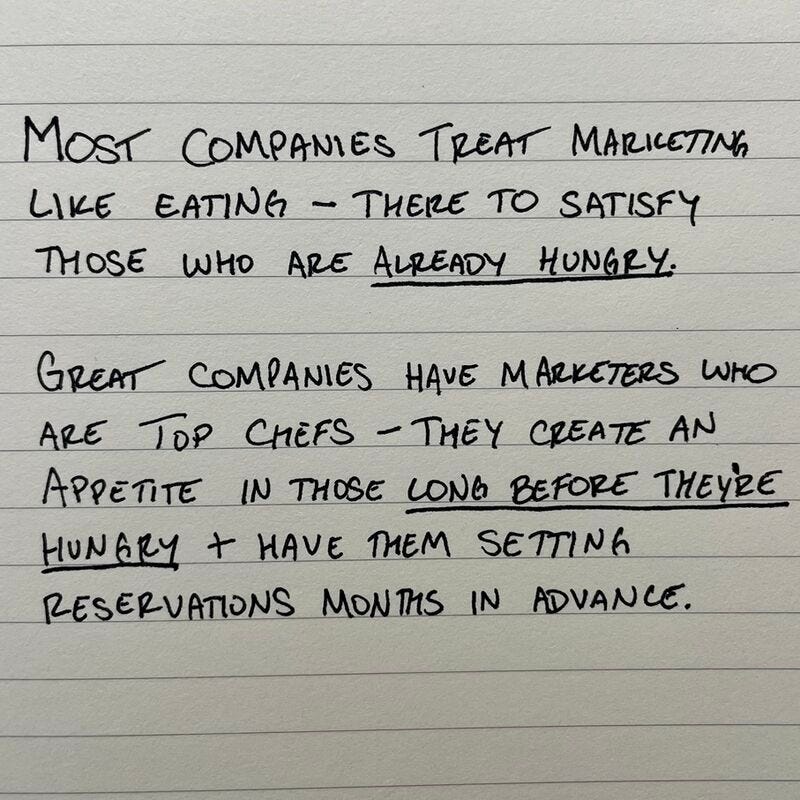The AI influencer dumpster fire
I’m not anti-AI.
But I am going to call a spade a spade when I see it. If I was managing “early me” in my marketing career right now, here’s the number one thing I’m advising him on:
Think very critically and evaluate the outcomes of the recent “AI Influencers” trend before deciding if they should be incorporated into our marketing strategy.
Sponsor: HockeyStack
Your CEO just slacked you: "We have our board meeting in 2 days. Send me a slide with what's working + anything they need to know."
Did your palms get sweaty reading that?
Or is this an easy ask because you can easily get to this info already?
I'm neurotic about forecasting + tracking performance. I have reports upon reports and dashboards upon dashboards.
So when Emir over at HockeyStack asked me what my perfect dashboard would look like, I immediately started geeking out. And when they sent this dashboard mock-up back to me, I was in nerd heaven 🙌
Q2 just wrapped up. And it's also never too late to add some solid reports or views to your dashboard, so hopefully this provides some inspiration to any of you who are looking to level up your dashboarding game.
Attention ≠ influence
This post showed up in my feed a month ago. It gave me pause as I watched the video and then went on to read the text within the post:
“The next generation of influencers won’t be born. They’ll be built.”
I couldn’t agree less with that statement. This entirely misses what influence is within the context of business - the ability to shape how someone thinks based on trust + credibility.
Trust and credibility can’t be built out of thin air.
Think about it:
When you want to learn about the latest in SEO or general best practices, you probably go see what people like Gaetano DiNardi or Rand Fishkin are saying.
When you want to stay up to date with the best LinkedIn ads tactics, you probably go see what people like Canberk Beker or Tim Davidson are sharing.
You can see where I’m going with this.
AI influencers can say the right things all day long. But they don’t have the credibility (read: receipts) that these practitioners have accumulated over their years in the space. That’s why when you see their face or their content, it carries a certain amount of weight behind what they’re sharing.
AI influencers don’t carry this type of weight. They’re reading a script that’s been fed into them, and that script can contain inputs from literally anyone.
This brings me around to the first key point I’d be telling my younger self:
This is not influence. This is attention-grabbing. These are not the same thing.
These AI videos are the shiny new objects. Humans have never seen videos like these before, so we’re drawn to them, highly curious about their contents. This is the definition of drawing attention. This isn’t a bad thing - it’s what we marketers are trying to do after all. But it should not be confused with influence.
Here’s a recent post from a business who is building + selling “AI influencers”
How do you feel after reading that?
As a marketer, you’re probably geeking out thinking about the possibilities of how you could use it.
Now take off your marketer hat and be an end user. Be the prospect of some piece of martech and imagine this type of content starts popping up in your feed regularly. Do you trust it? Do you believe in the promises they make? The outcomes they say you’ll get?
Call me a skeptic, but I sure as hell don’t trust it. If it’s as easy as feeding a prompt in and having a video spit out regurgitating that script, why isn’t the CEO or marketing leader of the company creating it?
Do they not want to have their reputation tied to the statements being made?
Do they not have the “time” to create videos like this for the market they serve?
To me, this new type of “AI influencer” is the equivalent of SEO keyword stuffing. You’re “showing up” in front of the audience you want to sell to, but there is zero substance behind the content once consumed. There’s a credibility gap.
The rise of the individual
The pendulum has already started to swing back. Have you caught yourself reading content or comments in recent weeks, and instead of thinking about the underlying contents of what was shared, you were thinking, “was this written by AI or a human?”
That’s your credibility alarm going off.
As I sat down to write about this this morning, I came across this post from Clark Barron hitting on this exact problem.
In it, he came to the same conclusion at the end of the post:
“GenAI isn’t just changing how we write. It’s corroding the conditions under which credibility can even be recognized.”
As marketers, where do we go from here? Do we accept this new era for what it is and follow the herd? Do we disagree with it, but have higher-ups telling us we have to do it so we do it under the pretext of “being told to do it”? Or do we reject it altogether?
I don’t know about you, but I’m in that last camp.
I played the “follow the crowd” game early in my career because I didn’t know any better and accepted what I was told to do by managers at face value. Then I had a “WTF am I doing with my life?” moment at work and started questioning everything. Why was I doing things the way I was doing them? Was there a better way? What was the justification for doing things the way “they’ve always been done”?
I’ve learned to trust that feeling when it comes up in my gut now. The “this just doesn’t seem quite right” feeling. Whenever this comes up, I immediately go into end-user-mode instead of marketer-mode and note how I feel from the other side of the table.
How do I reply when I get a LinkedIn comment that was clearly AI-written?
How do I absorb the content of an influencer video that was clearly an AI, not human?
With Veo we can create influencers who look good and say the right things. They can capture our attention like never before. And it’s disgustingly scalable to do
But marketing isn’t just about stopping the scroll, about capturing attention. True marketing also means changing how you think. This is the true definition of influence.
We’re at a fork in the road.
Most are going to take the route to the left + opt for artificial influence, mistaking the size of their reach for influence.
But a minority of people are going to take the route to the right + opt for real influence, measured not by the size of their reach, but by the depth of their reach.
And you know how you get to that kind of depth? Through credibility + trust. Through realness. Through typos. Through idiosyncrasies. Through anecdotes.
Hubspot’s CMO Kieran Flanagan shared this note in Substack the other week and had me connecting more dots into what this post-AI world will look like.
While we really don’t need any more “____-led growth” terms being introduced, I fully agree with his overarching thought here. What he calls “personality-led growth,” I simply think is the pendulum swinging back toward the individual from AI or larger entities.
It’s why LinkedIn prioritizes posts from individual vs. company pages.
It’s why I follow Kieran and not Hubspot.
It’s why I trust review videos on YouTube from real people.
It’s why we have a 3x higher open rate on the same exact email when it’s sent from our CEO instead of a generic “marketing@loxo.co” sender name.
We trust the individuals behind them, even despite the flaws we know they innately carry.
We develop relationships with the people on the other side of the screen + in person that become the reason we buy from them instead of a competitor.
AI influencers can’t do the above. It can’t be manufactured. It’s earned. It’s imperfect. And that’s exactly why it works.
Book quote of the week
“If you want others to like you, if you want to develop real friendships, if you want to help others at the same time as your help yourself, keep this principle in mind: Become genuinely interested in other people.”
- How to Win Friends and Influence People, by Dale Carnegie
In case you missed these this week
This simple concept illustrates why some brands have a never-ending queue of inbound interest
ABM is either reactive or proactive. Most teams choose reactive without realizing it.
We’re adding ‼️20‼️new sales team members (no, that’s not a typo)
See you next Saturday,
Sam








https://substack.com/@egretlane/note/p-168254677?r=5ezmlv&utm_medium=ios&utm_source=notes-share-action